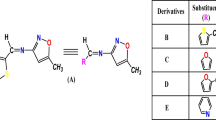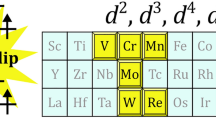Abstract
The electronic and optoelectronic properties of molecules constituted by benzene as linker, phenoxaborin as acceptor coupled with different types of donor moieties are investigated using the density functional theoretical method. The energy gap between the first excited singlet and triplet states (ΔEST) of the designed molecules (1–9) is found to be less than 0.5 eV suggesting them as ideal candidates for thermally activated delayed fluorescence (TADF) emitters. The analysis of frontier molecular orbitals of the molecules revealed a minimum spatial overlap between highest occupied molecular orbital (HOMO) and lowest unoccupied molecular orbital (LUMO) in favor of the small values of ΔEST. Among the molecules studied, the one in which dihydrophenazine acts as the donor has the lowest value of ΔEST. All designed molecules are good electron transporters. The non-linear optical properties of the molecules are also examined.



Similar content being viewed by others
Data Availability
The coordinates of the optimized geometries are provided in the supporting information.
References
Tang CW, VanSlyke SA (1987) Organic electroluminescent diodes. Appl Phys Lett 51:913–915
Tang CW, VanSlyke SA, Chen CH (1989) Electroluminescence of doped organic thin films. J Appl Phys 65:3610–3616
Adachi C, Baldo MA, Thompson ME, Forrest SR (2001) Nearly 100% internal phosphorescence efficiency in an organic light-emitting device. J Appl Phys 90:5048–5051
Baldo MA, Lamansky S, Burrows PE, Thompson ME, Forrest SR (1999) Very high-efficiency green organic light-emitting devices based on electrophosphorescence. Appl Phys Lett 75:4–6
Baldo MA, Adachi C, Forrest SR (2000) Transient analysis of organic electrophosphorescence. II. Transient analysis of triplet-triplet annihilation. Phys Rev B 62:10967–10977
Goushi K, Yoshida K, Sato K, Adachi C (2012) Organic light-emitting diodes employing efficient reverse intersystem crossing for triplet-to-singlet state conversion. Nat Photonics 6:253–258
Zhang Q, Li J, Shizu K, Huang S, Hirata S, Miyazaki H, Adachi C (2012) Design of efficient thermally activated delayed fluorescence materials for pure Blue Organic Light Emitting diodes. J Am Chem Soc 134:14706–14709
Youn Lee S, Yasuda T, Nomura H, Adachi C (2012) High-efficiency organic light-emitting diodes utilizing thermally activated delayed fluorescence from triazine-based donor–acceptor hybrid molecules. Appl Phys Lett 101:093306
Uoyama H, Goushi K, Shizu K, Nomura H, Adachi C (2012) Highly efficient organic light-emitting diodes from delayed fluorescence. Nature 492:234–238
Klessinger M (1995) Conical intersections and the mechanism of Singlet Photoreactions. Angew Chem Int Ed Engl 34:549–551
Méhes G, Nomura H, Zhang Q, Nakagawa T, Adachi C (2012) Enhanced Electroluminescence Efficiency in a Spiro-Acridine Derivative through Thermally activated delayed fluorescence. Angew Chem Int Ed 51:11311–11315
Fan J, Lin L, Wang C-K (2017) Excited state properties of non-doped thermally activated delayed fluorescence emitters with aggregation-induced emission: a QM/MM study. J Mater Chem C 5:8390–8399
Lee J, Shizu K, Tanaka H, Nomura H, Yasuda T, Adachi C (2013) Oxadiazole- and triazole-based highly-efficient thermally activated delayed fluorescence emitters for organic light-emitting diodes. J Mater Chem C 1:4599–4604
Paras CN, Ramachandran (2023) Tuning of the singlet–Triplet Energy gap of Donor-Linker-Acceptor based thermally activated delayed fluorescent emitters. J Fluoresc.
Paras A, Dhiman CN, Ramachandran (2022) Effect of aromatic linkers on thermally activated delayed fluorescence of selected organic molecules. Chem Phys Lett 139711
Vikramaditya T, Saisudhakar M, Sumithra K (2016) Computational study on thermally activated delayed fluorescence of donor–linker–acceptor network molecules. RSC Adv 6:37203–37211
Rajamalli P, Chen D, Suresh SM, Tsuchiya Y, Adachi C, Zysman-Colman E (2021) Planar and Rigid Pyrazine-Based TADF Emitter for Deep Blue Bright Organic Light-Emitting Diodes. Eur J Org Chem 2021:2285–2293
Lee GH, Kim YS, Pyridine (2018) Pyrimidine-, and triazine-based thermally activated delayed fluorescence emitters. J Nanosci Nanotechnol 18:7211–7215
Huang Y, Zhang D-H, Tao X-D, Wei Z, Jiang S, Meng L, Yang M-X, Chen X-L, Lu C-Z (2022) Triptycene-derived thermally activated delayed fluorescence emitters with combined through-bond and through-space charge transfers. Dyes Pigm 204:110397
Varathan E, Patnaik A (2019) Oxidation state-dependent Electronic properties of Sulfur-Containing thermally activated delayed fluorescence molecules. J Phys Chem A 123:8755–8765
Li X, Chen Y, Li S, Li A, Tu L, Zhang D, Duan L, Xie Y, Tang BZ, Li Z (2023) Quinoxaline-based thermally activated delayed fluorescence emitters for highly efficient organic light-emitting diodes. J Mater Chem C 11:5217–5224
Takahashi T, Shizu K, Yasuda T, Togashi K, Adachi C (2014) Donor–acceptor-structured 1,4-diazatriphenylene derivatives exhibiting thermally activated delayed fluorescence: design and synthesis, photophysical properties and OLED characteristics. Sci Technol Adv Mater 15:034202
Chang C-H, Kuo M-C, Lin W-C, Chen Y-T, Wong K-T, Chou S-H, Mondal E, Kwong RC, Xia S, Nakagawa T, Adachi C (2012) A dicarbazole–triazine hybrid bipolar host material for highly efficient green phosphorescent OLEDs. J Mater Chem 22:3832–3838
Lee SY, Yasuda T, Park IS, Adachi C (2015) X-shaped benzoylbenzophenone derivatives with crossed donors and acceptors for highly efficient thermally activated delayed fluorescence. Dalton Trans 44:8356–8359
Kawasumi K, Wu T, Zhu T, Chae HS, Van Voorhis T, Baldo MA, Swager TM (2015) Thermally activated delayed fluorescence materials based on Homoconjugation Effect of Donor–Acceptor triptycenes. J Am Chem Soc 137:11908–11911
Liu Y, Xie G, Wu K, Luo Z, Zhou T, Zeng X, Yu J, Gong S, Yang C (2016) Boosting reverse intersystem crossing by increasing donors in triarylboron/phenoxazine hybrids: TADF emitters for high-performance solution-processed OLEDs. J Mater Chem C 4:4402–4407
Park IS, Numata M, Adachi C, Yasuda T (2016) A phenazaborin-based high-efficiency blue delayed fluorescence material. Bull Chem Soc Jpn 89:375–377
Kitamoto Y, Namikawa T, Suzuki T, Miyata Y, Kita H, Sato T, Oi S (2016) Dimesitylarylborane-based luminescent emitters exhibiting highly-efficient thermally activated delayed fluorescence for organic light-emitting diodes. Org Electron 34:208–217
Suzuki K, Kubo S, Shizu K, Fukushima T, Wakamiya A, Murata Y, Adachi C, Kaji H (2015) Triarylboron-based fluorescent Organic Light-Emitting diodes with External Quantum efficiencies Exceeding 20%. Angew Chem Int Ed 54:15231–15235
Endo A, Sato K, Yoshimura K, Kai T, Kawada A, Miyazaki H, Adachi C (2011) Efficient up-conversion of triplet excitons into a singlet state and its application for organic light emitting diodes. Appl Phys Lett 98:083302
Zhang Q, Li B, Huang S, Nomura H, Tanaka H, Adachi C (2014) Efficient blue organic light-emitting diodes employing thermally activated delayed fluorescence. Nat Photonics 8:326–332
Tsai W-L, Huang M-H, Lee W-K, Hsu Y-J, Pan K-C, Huang Y-H, Ting H-C, Sarma M, Ho Y-Y, Hu H-C, Chen C-C, Lee M-T, Wong K-T, Wu C-C (2015) A versatile thermally activated delayed fluorescence emitter for both highly efficient doped and non-doped organic light emitting devices. Chem Commun 51:13662–13665
Fan J, Zhang Y, Zhou Y, Lin L, Wang C-K (2018) Excited State properties of a thermally activated delayed fluorescence molecule in Solid Phase studied by Quantum Mechanics/Molecular Mechanics Method. J Phys Chem C 122:2358–2366
Tsiko U, Bezvikonnyi O, Volyniuk D, Minaev BF, Keruckas J, Cekaviciute M, Jatautiene E, Andruleviciene V, Dabuliene A, Grazulevicius JV (2022) TADF quenching properties of phenothiazine or phenoxazine-substituted benzanthrones emitting in deep-red/near-infrared region towards oxygen sensing. Dyes Pigm 197:109952
Lee JM, Lee SW, Kim YS (2020) Highly Charge Transport thermally activated delayed fluorescence host materials based on Benzimidazole-Acridine derivatives. J Nanosci Nanotechnol 20:5070–5074
Yu L, Wu Z, Xie G, Zeng W, Ma D, Yang C (2018) Molecular design to regulate the photophysical properties of multifunctional TADF emitters towards high-performance TADF-based OLEDs with EQEs up to 22.4% and small efficiency roll-offs. Chem Sci 9:1385–1391
Zhao T, Jiang S, Tao X-D, Yang M, Meng L, Chen X-L, Lu C-Z (2023) Dihydrophenazine-derived thermally activated delayed fluorescence emitters for highly efficient orange and red organic light-emitting diodes. Dyes Pigm 211:111065
Fan J, Lin L, Wang C (2016) Decreasing the singlet–triplet gap for thermally activated delayed fluorescence molecules by structural modification on the donor fragment: first-principles study. Chem Phys Lett 652:16–21
Kitamoto Y, Namikawa T, Ikemizu D, Miyata Y, Suzuki T, Kita H, Sato T, Oi S (2015) Light blue and green thermally activated delayed fluorescence from 10H-phenoxaborin-derivatives and their application to organic light-emitting diodes. J Mater Chem C 3:9122–9130
Frisch MJ, Trucks GW, Schlegel HB, Scuseria GE, Robb MA, Cheeseman JR, Scalmani G, Barone V, Petersson GA, Nakatsuji H, Li X, Caricato M, Marenich AV, Bloino J, Janesko BG, Gomperts R, Mennucci B, Hratchian HP, Ortiz JV, Izmaylov AF, Sonnenberg JL, Williams-Young D, Ding F, Lipparini F, Egidi F, Goings J, Peng B, Petrone A, Henderson T, Ranasinghe D, Zakrzewski VG, Gao J, Rega N, Zheng G, Liang W, Hada M, Ehara M, Toyota K, Fukuda R, Hasegawa J, Ishida M, Nakajima T, Honda Y, Kitao O, Nakai H, Vreven T, Throssell K, Montgomery JA, Peralta JE Jr., Ogliaro F, Bearpark MJ, Heyd JJ, Brothers EN, Kudin KN, Staroverov VN, Keith TA, Kobayashi R, Normand J, Raghavachari K, Rendell AP, Burant JC, Iyengar SS, Tomasi J, Cossi M, Millam JM, Klene M, Adamo C, Cammi R, Ochterski JW, Martin RL, Morokuma K, Farkas O, Foresman JB, Fox DJ (2009) Gaussian, Inc., Wallingford CT, Kara YS, Sagdinc SG, Esme A (2012) Theoretical study on the relationship between the molecular structure and corrosion inhibition efficiency of long alkyl side chain acetamide and isoxazolidine derivatives. Prot Met Phys Chem Surf 48:710–721
Kara YS, Sagdinc SG, Esme A (2012) Theoretical study on the relationship between the molecular structure and corrosion inhibition efficiency of long alkyl side chain acetamide and isoxazolidine derivatives. Prot Met Phys Chem Surf 48(6):710–721. https://doi.org/10.1134/S2070205112060056
Jeewandara AK, de Silva KMN (2004) Are donor–acceptor self organised aromatic systems NLO (non-linear optical) active? J Mol Struct THEOCHEM 686:131–136
Samanta PK, Alam MM, Misra R, Pati SK (2019) Tuning of hyperpolarizability, and one- and two-photon absorption of donor–acceptor and donor–acceptor–acceptor-type intramolecular charge transfer-based sensors. Phys Chem Chem Phys 21:17343–17355
Guido CA, Cortona P, Mennucci B, Adamo C (2013) On the Metric of charge transfer Molecular excitations: a simple Chemical Descriptor. J Chem Theory Comput 9:3118–3126
Gruhn NE, da Silva Filho DA, Bill TG, Malagoli M, Coropceanu V, Kahn A, Brédas J-L (2002) The Vibrational Reorganization Energy in Pentacene: Molecular influences on Charge Transport. J Am Chem Soc 124:7918–7919
Lin BC, Cheng CP, You Z-Q, Hsu C-P (2005) Charge Transport Properties of Tris(8-hydroxyquinolinato)aluminum(III): why it is an Electron transporter. J Am Chem Soc 127:66–67
Hilborn RC (1982) Einstein coefficients, cross sections, f values, dipole moments, and all that. Am J Phys 50:982–986
Marcus RA, Sutin N (1985) Electron transfers in chemistry and biology, Biochim. Biophys Acta BBA - Rev Bioenerg 811:265–322
Gao X, Bai S, Fazzi D, Niehaus T, Barbatti M, Thiel W (2017) Evaluation of spin-orbit couplings with Linear-Response Time-Dependent Density Functional methods. J Chem Theory Comput 13:515–524
Reimers JR (2001) A practical method for the use of curvilinear coordinates in calculations of normal-mode-projected displacements and duschinsky rotation matrices for large molecules. J Chem Phys 115:9103–9109
Acknowledgements
Paras acknowledges Council of Scientific and Industrial Research (CSIR), New Delhi for the fellowship. CNR is grateful to the Scientific and Engineering Research Board (SERB) for the Research Grant EMR/2016/008024. The authors acknowledge Indian Institute Technology Roorkee for the infrastructure.
Funding
C. N. Ramachandran: Science and Engineering Research Board (SERB), Research Grant: EMR/2016/008024.
Author information
Authors and Affiliations
Contributions
CNR conceived the investigation. Paras performed the calculations. Both authors analyzed the results and wrote the manuscript.
Corresponding author
Ethics declarations
Ethical Approval
This research did not involve human or animal samples.
Competing Interests
The authors declare no competing interests.
Additional information
Publisher’s Note
Springer Nature remains neutral with regard to jurisdictional claims in published maps and institutional affiliations.
Supplementary Information
Below is the link to the electronic supplementary material.
Rights and permissions
Springer Nature or its licensor (e.g. a society or other partner) holds exclusive rights to this article under a publishing agreement with the author(s) or other rightsholder(s); author self-archiving of the accepted manuscript version of this article is solely governed by the terms of such publishing agreement and applicable law.
About this article
Cite this article
Paras, Ramachandran, C.N. Tuning the Electronic and Optical Properties of Phenoxaborin Based Thermally Activated Delayed Fluorescent Materials: A DFT Study. J Fluoresc (2024). https://doi.org/10.1007/s10895-023-03545-0
Received:
Accepted:
Published:
DOI: https://doi.org/10.1007/s10895-023-03545-0




